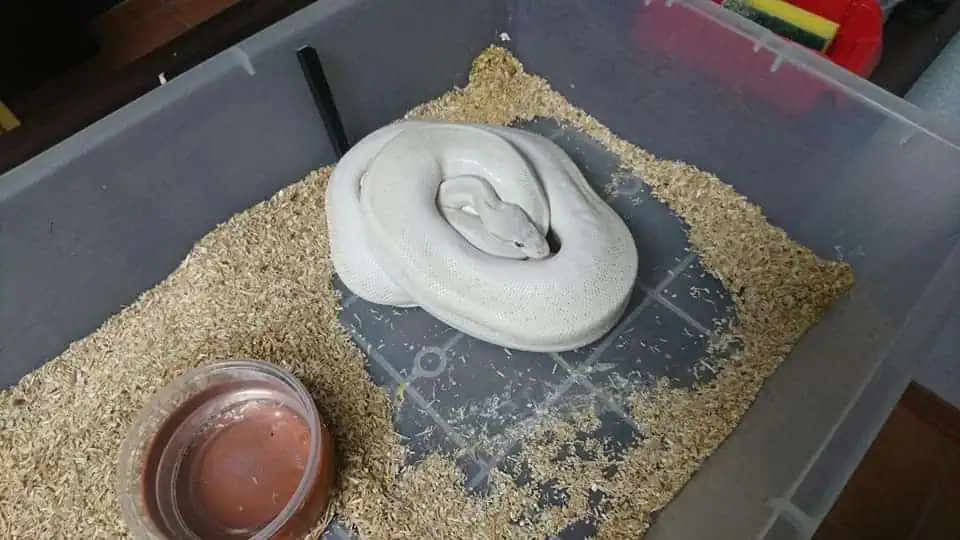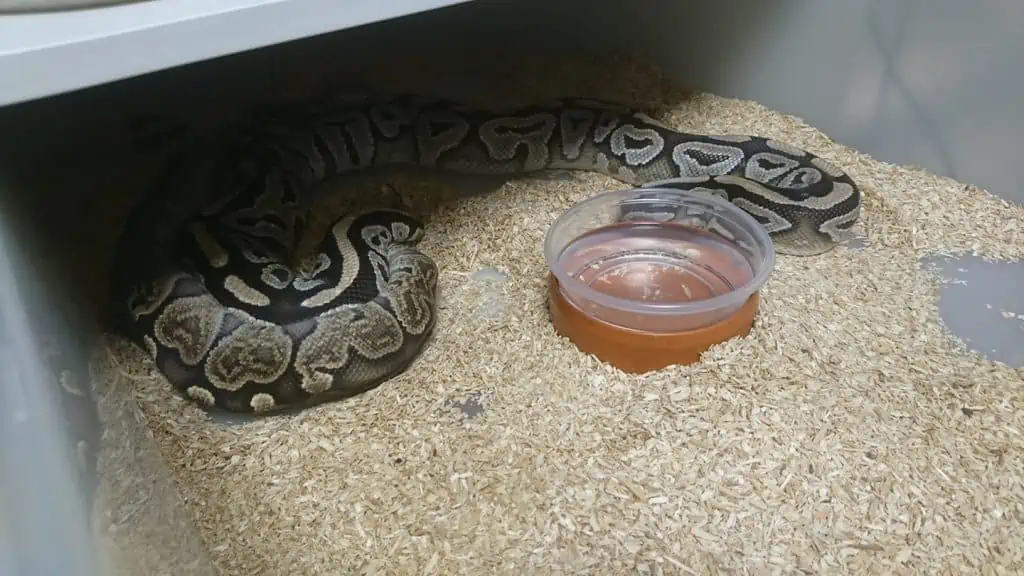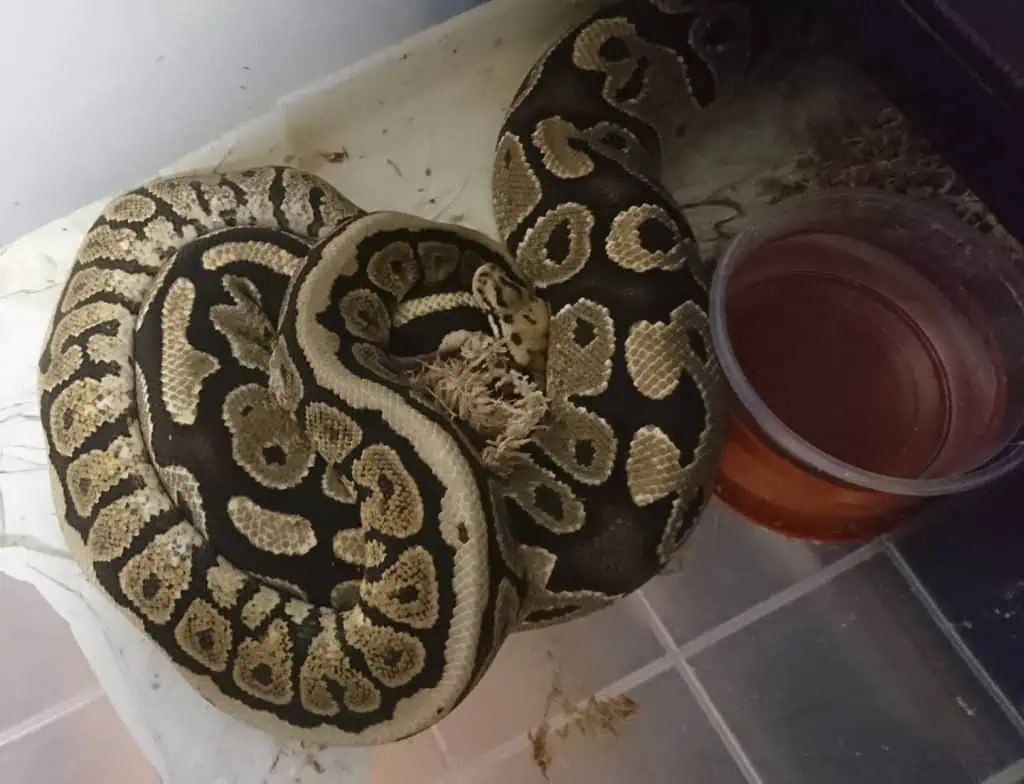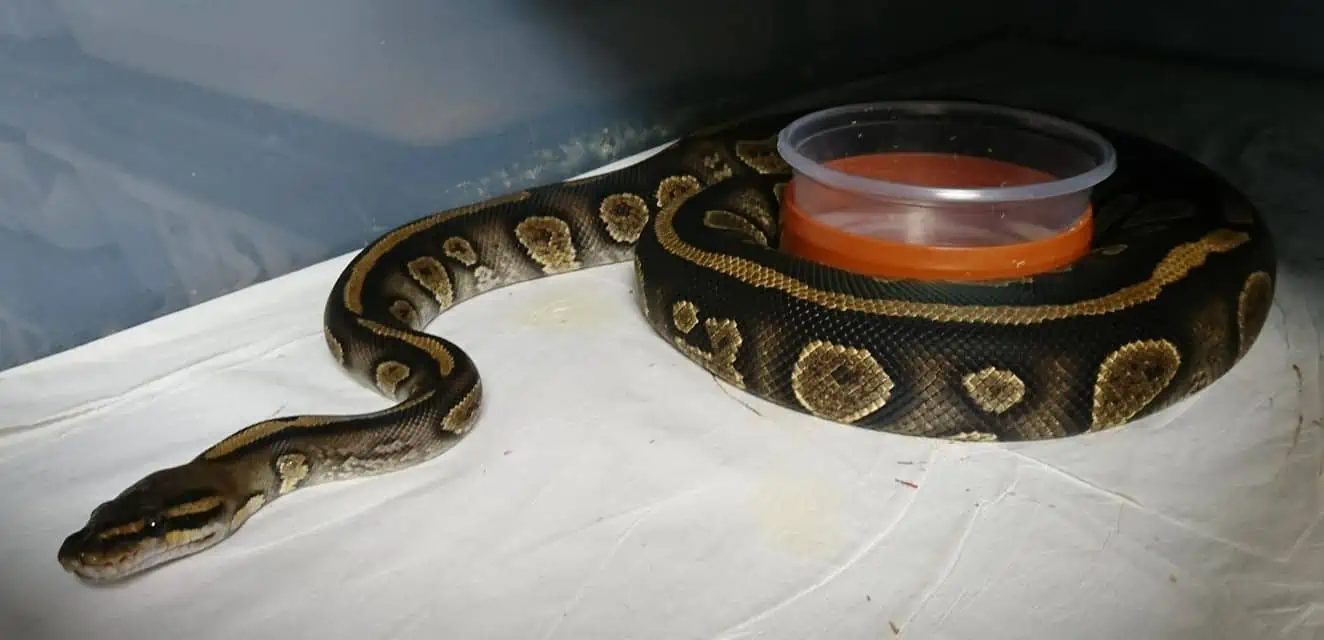Are you thinking of bringing a new ball python home? Creating the perfect enclosure for your ball python can be overwhelming, especially if you’re a beginner. Introducing an ideal tub size and setup will take their habitat to its highest potential. The perfect size and configuration of their enclosure may fluctuate based on the age and length of your snake. With the correct proportions in place and proper setup techniques, it will not only boost your snake’s health but also bolster its level of contentment drastically!
Many experienced ball python owners choose to use plastic storage tubs over glass enclosures as they are easier to maintain optimal humidity and temperature levels for your reptile friend.
To create a tub setup for your ball python, follow these steps:
- Select a tub of the right size
- Drill holes on the sides for ventilation
- Rinse and disinfect
- Install thermostat
- Setup under tank heater & connect it with the thermostat
- Install a thermometer and hygrometer
- Place water bowl, substrates, and hides
- Add décorations
In this article, we’ll discuss the tub setup for ball pythons, its installation process, along with its pros and cons.
What Is Tub Setup for Ball Python?
When it comes to housing ball pythons, there are many options available. One of the most popular options is a plastic tub with a lid and drilled air holes. This enclosure is known as an “enclosure tub” or “tub setup” and is preferred by many experienced keepers due to its simplicity & affordability.

Do Ball Pythons Do Better in Tubs?
Ball pythons can do well in tubs, depending on the size/style of the enclosure and the type of care given to the snake. Tubs provide a more secure enclosure for your pet, as they have fewer opportunities to escape. Tubs are a great way to provide ball pythons with a secure and comfortable enclosure that is easy to maintain.
They offer the ability to keep humidity levels high. Since tubs are made of plastic, they retain heat better than glass tanks which can make a huge difference in the comfort of your pet.
What Kind of Tub Should I Use?
When it comes to picking the best tub for your ball python, just go for a plastic storage tub, and consider a few important things I’ve mentioned below:
- Make certain that the tub has clear sides, so you can easily see your pet. This will also help in monitoring their behavior and activity levels.
- Look for sturdy construction that will withstand regular handling and cleaning.
- Locking latches are essential for safety and security. Ideally, there should be four latches in total – one on each side of the tub -, but at a minimum, there should be two latches, one on either end.
- Also, make sure the lid is well-secured so the snake cannot escape!
With these tips in mind, you should be able to find the perfect tub for your ball python!

How Do You Set Up a Ball Python Tub?
Setting up a home for your ball python can be a daunting task, especially if you are new to the reptile world. But with the right preparation and research, it is possible to create a safe, comfortable environment that will keep your pet happy and healthy.
Here I have outlined all the necessary steps to efficiently set up the perfect ball python tub.
1. Select a Tub of the Right Size
When selecting the appropriate size tub for your snake, consider its age. As a general rule of thumb, each side’s length should be equal to or greater than their overall length. I have observed younger snakes struggle more with locating warmth inside a larger space compared to adults who can maneuver bigger enclosures without difficulty. For ball pythons, here’s what I suggest at a minimum:
| Ball Python’s Age | Ball Python’s Size | Tub Size | Recommended Product |
| Hatchling | 60g – 500g | 15.75″L x 11.1″W x 5.50″H | Pekky 15 Quart Plastic Storage Box |
| Juvenile | 500g – 1000g | 29″L x 17. 750″W x 6. 125″H | Rubbermaid Cleverstore Clear 41 Qt, Stackable Plastic Containers |
| Adult | 1000g + | 34.38″L x 6″W x 15.5″H | Homz Large 41 Quart Clear Plastic Container |
2. Melt/Drill Holes for Ventilation
Creating a healthy and pleasurable home for your ball python requires proper ventilation. To give him the best air circulation, you’ll need these items to drill holes in his habitat:
- Soldering iron or electric drill
- Razor blade
- Lighter
Accurately measure your tub and recognize the warm and cool sides. The number of holes should be less on the hot side but more on the cold side to make a temperature gradient. After you are aware of where to put them:
- Begin drilling or soldering with your tools. Secure both ends as you go to reduce any risk of cracking while using an electric drill.
- Smooth out all rough edges utilizing a razor blade; then further soften these areas by heating up with a lighter so that no sharp points can hurt your animal companion(s).
3. Rinse and Disinfect the Tub
After you have finished drilling the holes, rinse your tub meticulously and ensure there are no leftover plastic fragments and that all openings are smooth. Leave it to dry for 24 hours so any chemical odors can evaporate too.
Then use an organic, reptile-safe cleaner such as Fluker’s Habitat Cleaner with its convenient brush accessory to disinfect your product securely and efficiently. Composed of natural enzymes, this eco-friendly solution is a great way to cleanse away dirt while being gentle on your pet’s environment.
4. Install the Thermostat/Rheostat
Now that the tub has been disinfected, it is time to install a thermostat or rheostat. A thermostat helps to maintain a consistent temperature inside the terrarium while providing extra protection against overheating. It also allows you to control your setup’s night and day temperatures with the flick of a switch.
This setup consists of plugging it into the wall and attaching the probe either on the physical heating element itself, on the outside of the tub, or at the bottom of the tub underneath the substrate where it’s touching the hottest spot.
5. Set Up the Under-Tank Heater & Attach It to Your Thermostat
The next step is to install the Under Tank Heater (UTH). This can involve heat tape or a heating pad, both of which provide adequate warmth for your pet’s tropical environment. For safety reasons, be sure there is a separation of at least 1/4″ inch between the tub and the carpet/floor when using a heat tape; otherwise, heat will not be regulated correctly.
If you prefer using heat pads, simply adhere them to one side of your pet’s habitat – occupying an area roughly equal in size as your snake coiled up – which should cover around 1/3rd of its total capacity.
Avoid leaving heat tape touching the tub for any duration without a thermostat to regulate it – this can easily cause harm to your pet, so be sure to attach these components securely with a stat.
6. Install a Thermometer
As your ball python is cold-blooded, it needs both a warm and cool side in its habitat to properly regulate body temperature. Investing in a digital thermometer with a remote probe is essential to ensure that you accurately monitor the temperatures of your pet’s home.
With this tool, you only need to place the probe over the hottest spot and underneath the substrate within the tub for accurate measurements, which are then read on an easy-to-read digital display!
7. Install Hygrometers
To ensure your ball python remains healthy and content, it is important to be mindful of the humidity levels in its enclosure. The ideal range should remain between 50% and 60%. Sub-optimal humidity can lead to a variety of ailments, such as shedding issues, respiratory infections, and more.
To ensure accuracy when monitoring this level, I recommend acquiring two digital hygrometers like Exo Terra Digital Hygrometer, one for the cool side and one for the warm side.
8. Place a Water Bowl
Position the water bowl on the side of the tub in a warm environment – this will enable more humidity to develop, providing your pet with everything it needs. To minimize any danger of overturning, select one that is sufficiently heavy. Make sure it’s big enough for your snake to soak in and has flat sides!
9. Add a Substrate
When selecting your substrate, it’s important to consider the level of humidity and cleaning required. With so many options available, you will need to evaluate factors such as the climate in which your pet lives, the size of the enclosure, and other environmental conditions.
Some substrates are more suitable for dry areas, while others may be better suited for humid locations – make sure you choose carefully!
10. Incorporate Hides of Appropriate Size
Ball pythons are creatures that crave solitude and a feeling of security; thus, it is paramount that you provide your pet with a minimum of two hideouts. Place one on the hot side and another on the cold side – each should feature only one entranceway, which must be slightly larger than your snake’s size so it can feel snug inside.
However, if it’s too big, it won’t offer as much comfort for them. As soon as your ball python grows bigger in size, upgrade their lodgings accordingly!
11. Furnishings
To make your ball python feel right at home, it is important to have the proper furnishings. Consider adding decorations such as artificial plants and fake rock formations – these will not only liven up the environment of its enclosure but also help reduce excess space in particularly large spaces.
Doing so allows you to create a comfortable habitat that’s sure to bring joy and contentment to your snake!

Pros and Cons of Using a Tub for Ball Pythons
The use of plastic tubs as living quarters for ball pythons has become increasingly popular in recent years. While some owners prefer the convenience of these enclosures, other keepers are concerned about their safety and suitability as a home for their pet snake.
Here I’ve compiled both advantages and disadvantages of using a tub for your pet.
Pros
- Maintains temperature and humidity levels
- Lightweight
- Easy to clean
- Efficient
- Affordable
- Portable (can be used as a temporary home while traveling)
- Its small size compared to a tank setup allow you to keep an eye on your pet easily.
Cons
- Easy for larger pets to escape from if not properly secured.
- Not ideal for display purposes.
- Not enough space for branches to climb.
- Limited space for enrichment and activity.
- It can be hard to monitor the health of the snake inside.
- It can become smelly or moldy if not regularly cleaned or ventilated.
- Ventilation can be inadequate in some plastic tubs.
- No proper lighting setup
It’s Your Turn!
The ideal tub setup size and design for a ball python can be simple or complex, depending on your pet’s individual needs. As a reptile owner, you should consider factors such as age, size, activity level, snake temperament, and climate before making any decisions. Creating a secure and pleasant environment for your ball python is paramount.
By carefully designing their habitat and providing it with the necessary maintenance, you can ensure they have a happy home to live in. Your snake will thank you!
Do you use a tub setup for your ball python? How did you create this setup? Share your experience in the comments section below!


